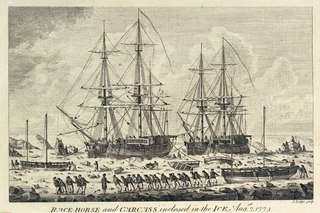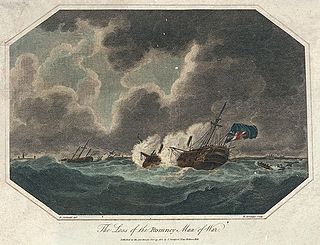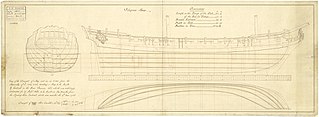
HMS Carcass was an Infernal-class bomb vessel of the Royal Navy, later refitted as a survey vessel. A young Horatio Nelson served aboard her as a midshipman on an expedition to the Arctic in 1773.

HMS Investigator was the mercantile Fram, launched in 1795, which the Royal Navy purchased in 1798 and renamed HMS Xenophon, and then in 1801 converted to a survey ship under the name HMS Investigator. In 1802, under the command of Matthew Flinders, she was the first ship to circumnavigate Australia. The Navy sold her in 1810 and she returned to mercantile service under the name Xenophon. She was probably broken up c.1872.

HMS Romney was a 50-gun fourth rate of the Royal Navy. She served during the American War of Independence, and the French Revolutionary and Napoleonic Wars in a career that spanned forty years. Five ships of the Royal Navy have been named HMS Romney. The origins of the name are from the town of New Romney, although it may be that the name entered the Royal Navy in honour of Henry Sydney, 1st Earl of Romney.

HMS Salamander was one of the initial steam powered vessels built for the Royal Navy. On 10 January 1831 the First Sea Lord gave orders that four paddle vessels be built to competitive designs. The vessels were to be powered by Maudslay, Son & Field steam engines, carry a schooner rig and mount one or two 10-inch shell guns. Initially classed simply as a steam vessel (SV), she was re-classed as a second-class steam sloop when that categorization was introduced on 31 May 1844. Designed by Joseph Seaton, the Master Shipwright of Sheerness, she was initially slated to be built in Portsmouth, and was changed to Sheerness Dockyard. She was launched and completed in 1832, took part in the Second Anglo-Burmese War and was broken up in 1883.

HMS Lizard was a 28-gun Coventry-class sixth-rate frigate of the Royal Navy, in service from 1757 to 1828. Named after the Lizard, a peninsula in southern Cornwall, she was a broad-beamed and sturdy vessel designed for lengthy periods at sea. Her crewing complement was 200 and, when fully equipped, she was armed with 24 nine-pounder cannons, supported by four three-pounders and twelve 1⁄2-pounder swivel guns. Despite her sturdy build, she was plagued with maintenance problems and had to be repeatedly removed from service for repair.

HMS Aquilon was a 28-gun Coventry-class sixth-rate frigate of the Royal Navy. Launched in 1758, she saw active service against the French during the Seven Years' War, capturing seven enemy vessels in the first eight months of 1761. She was declared surplus to Navy requirements and sold into private hands in 1776.

HMS Racehorse was an 18-gun ship-rigged sloop of the Royal Navy. Originally the French ship Marquis de Vaudreuil, she was captured by the Royal Navy in 1757 and refitted as a survey vessel for the 1773 Phipps expedition towards the North Pole. Renamed HMS Thunder in 1775, she was captured back by the French in 1778.
HMS Aldborough was a 24-gun sixth-rate ship of the Royal Navy, purchased in 1706 and in service in Mediterranean and English waters until 1727 when she was rebuilt as a 374 ton sixth rate in accordance with the 1719 Establishment for Sixth Rates. After the rebuild she spent her career in the West Indies, Home Waters and the Mediterranean. She was finally broken at Deptford on 31 March 1742.
HMS Hawk was an eight-gun snow-rigged sloop of the Royal Navy, the second of three Drake class sloops constructed during the Anglo-Spanish War of Jenkins' Ear. Launched in 1741, her principal service was as convoy escort and patrol in the Irish Sea. She was broken up at Deptford Dockyard in 1747.
HMS Swift was an 8-gun snow-rigged sloop of the Royal Navy, the last of three Drake class sloops constructed during the Anglo-Spanish War of Jenkins' Ear. Launched in 1741, her principal service was as convoy escort and patrol off North Carolina and in the North Sea. She was lost at sea on 31 October 1756.

HMS Wolf was a 14-gun snow-rigged sloop of the Royal Navy, launched in 1742 as the first of three Wolf-class sloops constructed for action against Spanish privateers during the War of Jenkins' Ear.
HMS Infernal was an 8-gun bomb vessel of the Royal Navy, constructed in 1757 and in service until 1763. Designed by Thomas Slade, she was the prototype for six subsequent Infernal class bomb vessels which saw service in the Mediterranean and the West Indies during the Seven Years' War with France. In 1760 she was refitted as a sloop and returned to active service in the Caribbean.
HMS Constant was an Archer–class gun-brig of the Royal Navy, launched in 1801 for service against the French during the French Revolutionary and Napoleonic Wars. She was variously stationed in English home waters, the Baltic, the Caribbean, and off the coast of Spain, and was responsible for the capture of at least seven enemy vessels during her fifteen years at sea. The Royal Navy sold Constant at Chatham Dockyard in 1816.
HMS Lys was a 24-gun sloop-of-war of the Royal Navy which saw active service between 1745 and 1748, during the War of the Austrian Succession. Originally the French privateer Le Lis, she was captured by the Royal Navy in 1745 and refitted as a privateer hunter. In this role she secured a single victory at sea with the capture of a 10-gun French vessel in 1747. She was declared surplus to Navy requirements in 1748 and sold into private hands in 1749.

HMS Diligence was a 10-gun Alderney-class sloop of the Royal Navy which saw active service during the Seven Years' War and the American Revolutionary War. Launched in 1756, she was a successful privateer hunter off the coast of France before being reassigned to North American waters in 1763. Fifteen years later she was briefly refitted as a receiving ship for press ganged sailors brought into Sheerness Dockyard, before being re-registered in August 1779 as the fireship Comet.

HMS Swallow was a 14-gun Merlin-class sloop of the Royal Navy. Commissioned in 1745, she initially served in home waters as a convoy escort and cruiser before sailing to join the East Indies Station in 1747. There she served in the squadron of Rear-Admiral Edward Boscawen, taking part in an aborted invasion of Mauritius and the Siege of Pondicherry. In 1755 Swallow returned home to join the Downs Station, as part of which she fought at the Raid on St Malo, Raid on Cherbourg, and Battle of Saint Cast in 1758. She was also present when the French fleet broke out of Brest prior to the Battle of Quiberon Bay in 1759.
HMS Gibraltar was a member of the Gibraltar Group of 24-gun sixth rates. After commissioning she spent her career in Home waters and North America on trade protection duties. She was rebuilt at Deptford between 1725 and 1727. After her rebuild she served in Home Waters, North America, West Indies and the Mediterranean on trade protection. She was sold in 1749.

The Perseverance-class frigate was a 36-gun, later 42-gun, 18-pounder fifth-rate frigate class of twelve ships of the Royal Navy, constructed in two batches. Designed by Surveyor of the Navy Sir Edward Hunt the first iteration, consisting of four ships, was constructed as a rival to the similar Flora-class frigate. Strongly built ships, the Perseverance class provided favourable gunnery characteristics and was highly manoeuvrable, but bought these traits with a loss of speed. The name ship of the class, Perseverance, was ordered in 1779 and participated in the American Revolutionary War, but her three sister ships were constructed too late to take part. The class continued in service after the war, but soon became outdated.
HMS Tartar was a 32-gun fifth rate built by the Woolwich Dockyard in 1702. Her initial commissioning was in time for the War of the Spanish Succession. She partook in the Battle of Velez Malaga in 1704. She spent the rest of her career on counter piracy and trade protection patrols. She was rebuilt as a 20-gun sixth rate in 1733. She was finally broken in 1755.

Adam Hayes (1710–1785) was an 18th century shipbuilder to the Royal Navy. A great number of his models survive.













